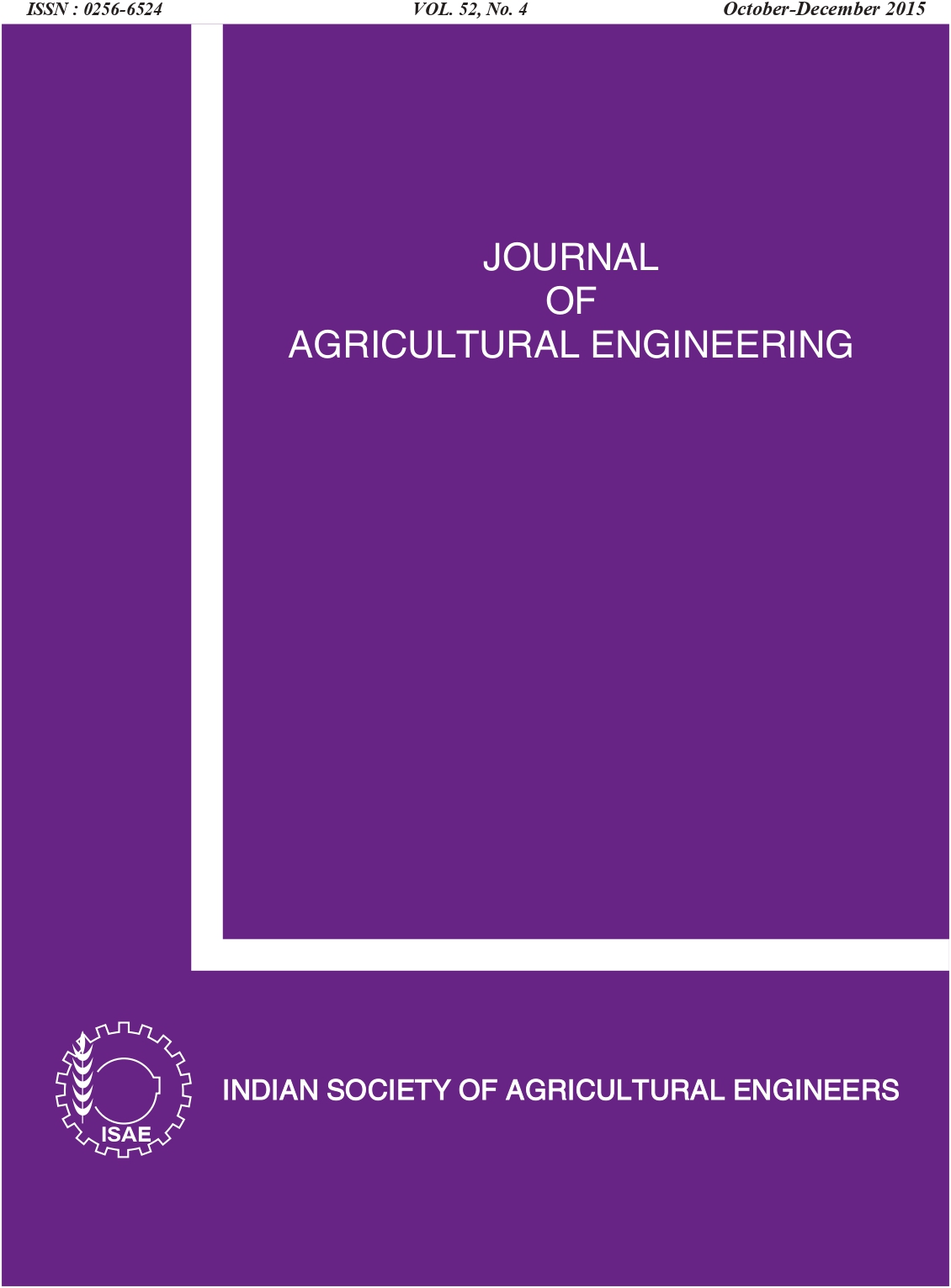Modelling Nutrient Leaching Below Crop Root Zone of Onion under Drip Fertigation
DOI:
https://doi.org/10.52151/jae2015524.1591Keywords:
HYDRUS-2D, fertigation strategy, nutrient leaching, modelling, onionAbstract
An experiment was conducted during the year 2008 and 2009 to study nutrient distribution (phosphorus, P; potassium, K and sulphur, S) under different fertigation strategies and to quantify the leaching of nutrients in onion crop. The study involved field experiment, laboratory analysis and modelling of P, K and S leaching and scenario generation for different types of soil and emitter discharge rates. Field data were used to calibrate and validate HYDRUS-2D model for solute transport. From the model performance parameters, HYDRUS-2D model was found to be good for predicting the P, K and S distribution in soil. The validated model was used for the simulations which were carried out on different soil types as well as with different fertigation and irrigation strategies. The results revealed that leaching of these nutrients was negligible in fine textured silty clay loam soil, whereas highest leaching occurred in coarse textured sandy loam soil. While considering discharge rate, more leaching was observed in case of emitter with higher discharge rate. Fertigation strategy also played an important role in leaching of P, K and S. Maximum leaching was observed in fertigation during first half of irrigation duration, whereas minimum leaching of P, K and S was observed with fertigation during second half of irrigation duration with two-day irrigation interval. It was concluded that 2.5 l.h-1 emitter discharge rate is suitable to reduce the leaching of nutrients, as well as minimize the free drainage of water with two-day irrigation interval in onion field.
References
Ajdary K. 2008. Simulation of nitrogen distribution in soil with drip irrigation system. J. Applied Sci., 8(18), 3157-3165.
Ajdary K; Singh D K; Singh A K; Khanna Manoj. 2007. Modeling of nitrogen leaching from experimental onion field under drip fertigation. Agric. Water Manage., 89, 15–28.
Allen R G; Pereira L S; Raes D; Smith M. 1998. Crop evapotranspiration. Guidelines for computing crop water requirements. FAO Irrigation and Drainage Paper No. 56, FAO, Rome, Italy, pp: 300.
Clothier B E; Sauer T J. 1988. Nitrogen transport during drip fertigation with urea. Soil Sci. Soc. Am. J., 52, 345–349.
Dangler J M; Locascio S. 1990. Yield of trickle-irrigated tomatoes as affected by time of N and K application. J.Amer. Soc. Hort. Sci., 115, 585-589.
Gardenas A I; Hopmans J W; Hanson B R; Simunek J. 2005. Two-dimensional modelling of nitrate leaching for various fertigation scenarios under micro-irrigation. Agric. Water Manage., 74(3), 219-242.
Hanson B R; Simunek J; Hopmans J W. 2006. Evaluation of urea–ammonium–nitrate fertigation with drip irrigation using numerical modeling. Agric. Water Manage., 86,102–113.
Hebbar S S; Ramachandrappa B K; Nanjappa H V; Prabhakar M. 2004. Studies on NPK drip fertigation in filed grown tomato (Lycopersicon esculentum Mill.). Eur. J. Agron., 21, 117-127.
Hochmuth G J. 1994. Plant petiole sap-testing guide for vegetable crops. Fla. Coop. Ext. Serv. Circ., 1144.
Jalali M. 2005. Release kinetics of non-exchangeable potassium in calcareous soils. Communications in Soil Science and Plant Analysis, 36, 1903–1917.
Li J; Zhang J; Rao M. 2004. Wetting patterns and nitrogen distributions as affected by fertigation strategies from a surface point source. Agric. Water Manage., 67(2), 89-104.
Li J; Zhang J; Rao M. 2005. Modeling of water flow and nitrate transport under surface drip fertigation. Trans. ASAE, 48 (2), 627-637.
Li J; Zhang J; Ren L. 2003. Water and nitrogen distribution as affected by fertigation of ammonium nitrate from a point source. Irrig. Sci., 22(1), 19–30.
Locascio S J; Olson S M; Rhoads F M. 1989. Water quantity and time of N and K application for trickle-irrigated tomatoes. J. Amer. Soc. Hort. Sci., 114, 265-268.
Mailhol J C; Ruelle P; Nemeth I. 2001. Impact of fertigation practices on nitrogen leaching under irrigation. Irrig. Sci., 20, 139–147.
Mmolawa K; Or D. 2000. Water and solute dynamics under a drip irrigated crop: experiments and analytical model. Trans. ASAE, 43(6), 1597-1608.
Narda N K; Chawla J K. 2002. A simple nitrate sub model for trickle fertigated potatoes. Irrig. Drain., 51, 361–371.
Patel N; Rajput T B S. 2000. Effect of fertigation on growth and yield of onion. In: Micro Irrigation, CBIP publication No. 282, 451-454.
Pote D H; Daniel T C; Sharpley A N; Moore P A; Edwards D R; Nichols D J. 1996. Relating extractable phosphorus in a silt loam to phosphorus losses in runoff. Soil Sci. Soc. Am. J., 60, 855–859.
Rajput T B S; Patel N. 2006. Water and nitrate movement in drip-irrigated onion under fertigation and irrigation treatments. Agric. Water Manage., 79 (3), 293-311.
Satpute S T. 2011. Modeling nutrient distribution underdrip fertigation in Onion (Allium cepa L.) crop. Unpublished Ph. D. thesis, IARI, New Delhi, 76-97.
Simunek J; Sejna M; van Genuchten M Th. 1999. The HYDRUS-2D Software Package for Simulating Two-Dimensional Movement of Water, Heat, and Multiple Solutes in Variable Saturated Media. Version 2.0. IGWMCTPS-53, International Ground Water Modeling Center, Colorado School of Mines, Golden, Colorado, pp: 1–251.
Somma F; Clausnitzer V; Hopmans J W. 1998. Modeling of transient three-dimensional soil water and solute transport with root growth and water and nutrient uptake. Plant Soil, 202, 281-293.














